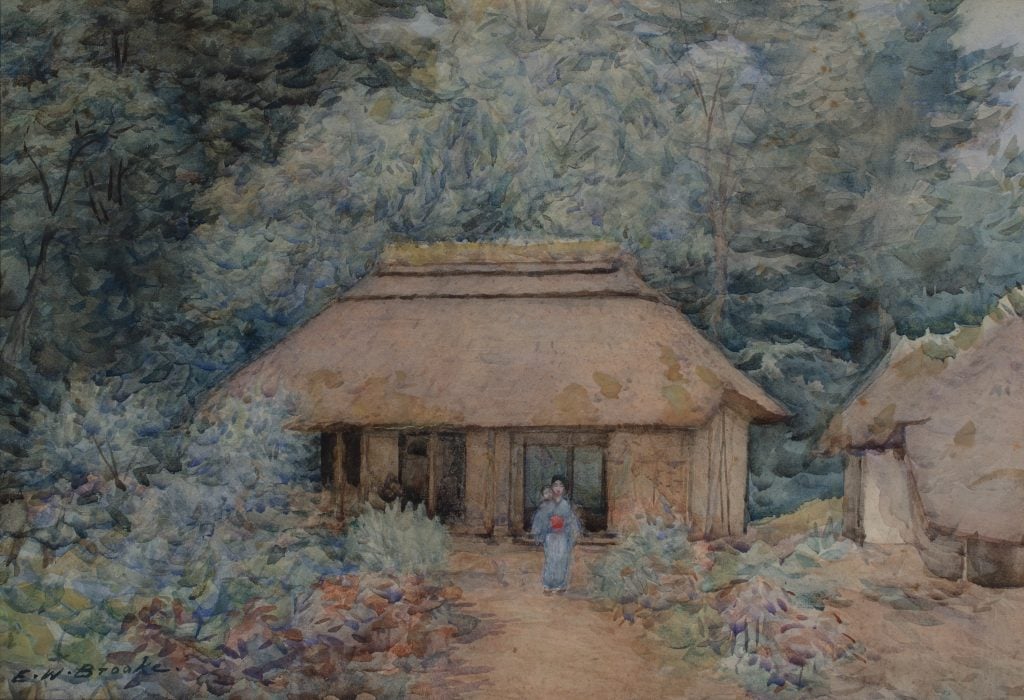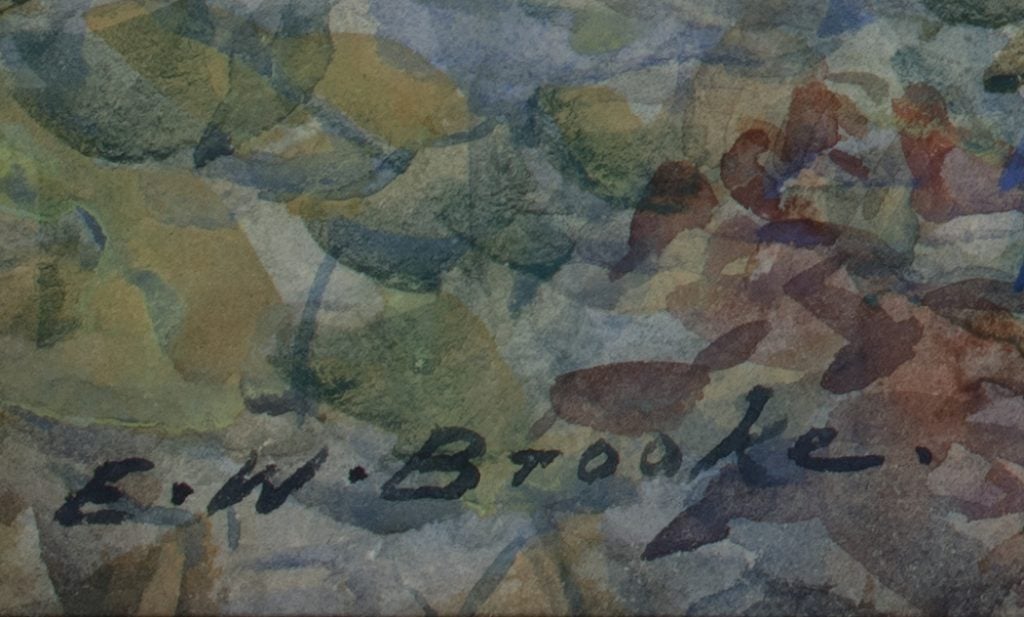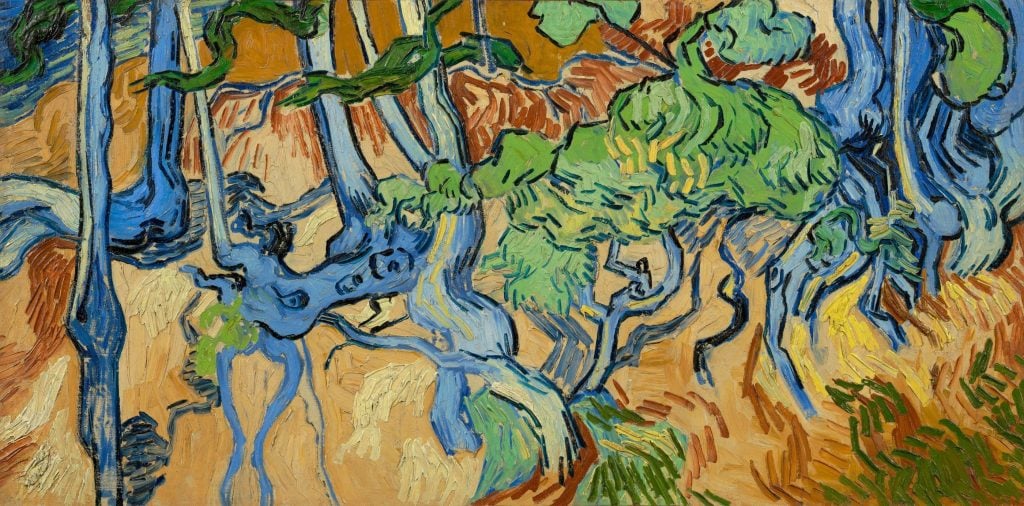Art World
Can This $45 Thrift Store Painting Provide Clues About Vincent Van Gogh’s Final Days in France? Art Historians Are Hoping So
It appears to be the work of Edmund Walpole Brooke, an artist who knew Van Gogh in his final days.

It appears to be the work of Edmund Walpole Brooke, an artist who knew Van Gogh in his final days.

Sarah Cascone

An unassuming thrift-shop find appears to have a tantalizing tie to the final days of Vincent van Gogh. A watercolor painting recently purchased at a Maine store bears the signature E.W. Brooke, suggesting that it could be the first known work of the artist Edmund Walpole Brooke, who painted with Van Gogh in the months before his death.
Katherine Mathews bought the painting earlier this spring at Warehouse 839 in the town of Saco for just $45, as first reported by the New York Times. The store’s owner, Kevin Keraghan, had originally purchased it as part of a New Hampshire estate.
“It hung in my house for 15 years,” Keraghan told Artnet News of the painting, which depicts a woman in a kimono carrying a baby on her back, in front of two Japanese-style buildings and a tree-filled landscape. He had tried researching the artist when he first acquired the work, but wasn’t able to learn much.
“I liked the image so it didn’t matter,” he said. “But now I like Modern stuff, so I brought it to my shop.”

The signature E.W. Brooke suggests this painting is the first known work by Edmund Walpole Brooke, an obscure artist who was one of Vincent van Gogh’s last associates. Photo courtesy of John Mathews.
That’s when it caught the eye of its new owner. “In each room of my house, I have something from Kevin’s shop,” Mathews told Artnet News. “He opens every other weekend, and I usually expect to find something interesting.”
“I was flipping through some paintings and I saw the mother with the little baby peeking over her shoulder and I thought, ‘Oh, I love that,'” Mathews added. “I never imagined it would have this story connected to it.”
Some sleuthing turned up the research of Tsukasa Kōdera, a curator and professor of art history at Osaka University in Japan. Mathews realized that E.W. Brooke might be Edmund Walpole Brooke, a young painter who Van Gogh spoke of in a letter to his brother, Theo van Gogh.
“In those days there were many painters, including American painters, in Auvers, probably because of the beauty of landscapes,” Kōdera told Artnet News in an email. The town, 20 miles north of Paris, was where Van Gogh made his last works before dying of a gun shot wound, likely self-inflicted, in July 1890.

Vincent van Gogh, Tree Roots (1890), the artist’s final work, painted in Auvers. Courtesy of the Van Gogh Museum, Amsterdam, and the Vincent Van Gogh Foundation.
“An Englishman, Australian, called Walpole Brooke will probably come to see you,” Van Gogh wrote to Theo on July 2, 1890. “He’ll probably show you some of his studies, which are still rather lifeless, but however he does observe nature. He has been here in Auvers for months, and we went out together sometimes, he was brought up in Japan, you would never think so from his painting—but that may come.”
When Mathews reached out to Kōdera, he suggested they look for a watermark on the painting. Held up to the light, the paper bore the name J. Whatman, a British paper manufacturer popular with turn-of-the-century artists, including Van Gogh. The period-appropriate materials and Japanese subject matter both suggest the work could be the first documented Brooke painting.
Born to English parents in Australia in 1865, Brooke and his family moved to Japan in 1869. He grew up in Yokohama and moved to Paris in 1885 to study art. When a 24-year-old Brooke met Van Gogh five years later, his childhood would probably have intrigued the older artist, who was deeply interested in Japanese art and culture.

Vincent van Gogh, Portrait of Père Tanguy (1877). The portrait features the artist’s extensive collection of Japanese prints. Courtesy of the Musée Rodin, Paris.
“Vincent was fascinated by Japanese prints and would have been very excited to meet someone who had actually been to Japan,” Martin Bailey, a Van Gogh specialist and writer for the Art Newspaper, told Artnet News in an email. “Brooke’s work has remained unknown, so it is wonderful if one of his Japanese works has been discovered.”
There are few records of Brooke’s life and career. He showed a painting at the Royal Academy in London in 1890 and 1891, and the Paris Salon in 1891. Brooke then returned to Yokohama, where he held solo shows in 1894 and 1896.
Tragedy struck in 1923 when the Great Kanto earthquake destroyed much of Yokohama’s foreign settlement. Brooke’s house burned to the ground, likely destroying his life’s work. He died in Kobe in 1938.
Though little is known about Brooke’s life in Japan after leaving France, it appears that he had a daughter. A grave in Yokohama’s foreign cemetery bears the name Ume Brooke, who died in childhood. The newly discovered watercolor could very well depict the artist’s wife and child in happier days.

The mother and child figure in the painting could be Edmund Walpole Brooke’s family. Photo courtesy of John Mathews.
“My guess is [Brooke] mailed it to a family member. He had a lot of siblings, including two in California,” Katherine Mathews said. She hasn’t had any luck reaching out to the artist’s relatives in search of correspondence or other records about Brooke, but the family who owned the New Hampshire beach house where the painting was found did originally come from California.
Kōdera is hopeful that the publicity around this unlikely discovery in Maine will help bring more works by Brooke out of the woodwork. Though the work’s attribution to the artist remains tentative, finding additional examples will help art historians learn more about Brooke’s style to better authenticate it.
And though $45 may seem like a bargain considering the painting’s link to one of the world’s most famous artists, Kōdera doesn’t expect a market boom for Brooke’s work, even if more examples turn up.
“It could be more expensive in the future, but that all depends on further discoveries and research and that will take many decades,” he said.
Regardless of monetary value, the painting’s unique history continues to fascinate those involved. “I couldn’t believe it. It’s a wonderful story,” Keraghan said. “Kathy [Mathews] actually offered me the painting back. I told her, ‘No, you do what you want with it.'”
“We are humbled to play even a small part in helping piece together the story of E.W. Brooke and his relationship with Van Gogh,” Mathews’s husband, John Mathews, told Artnet News in an email.
The couple originally hung the painting in their dining room, but have since covered it with a cloth to protect it from the light. Katherine Mathews added: “I would love for the piece to be displayed in Japan.”